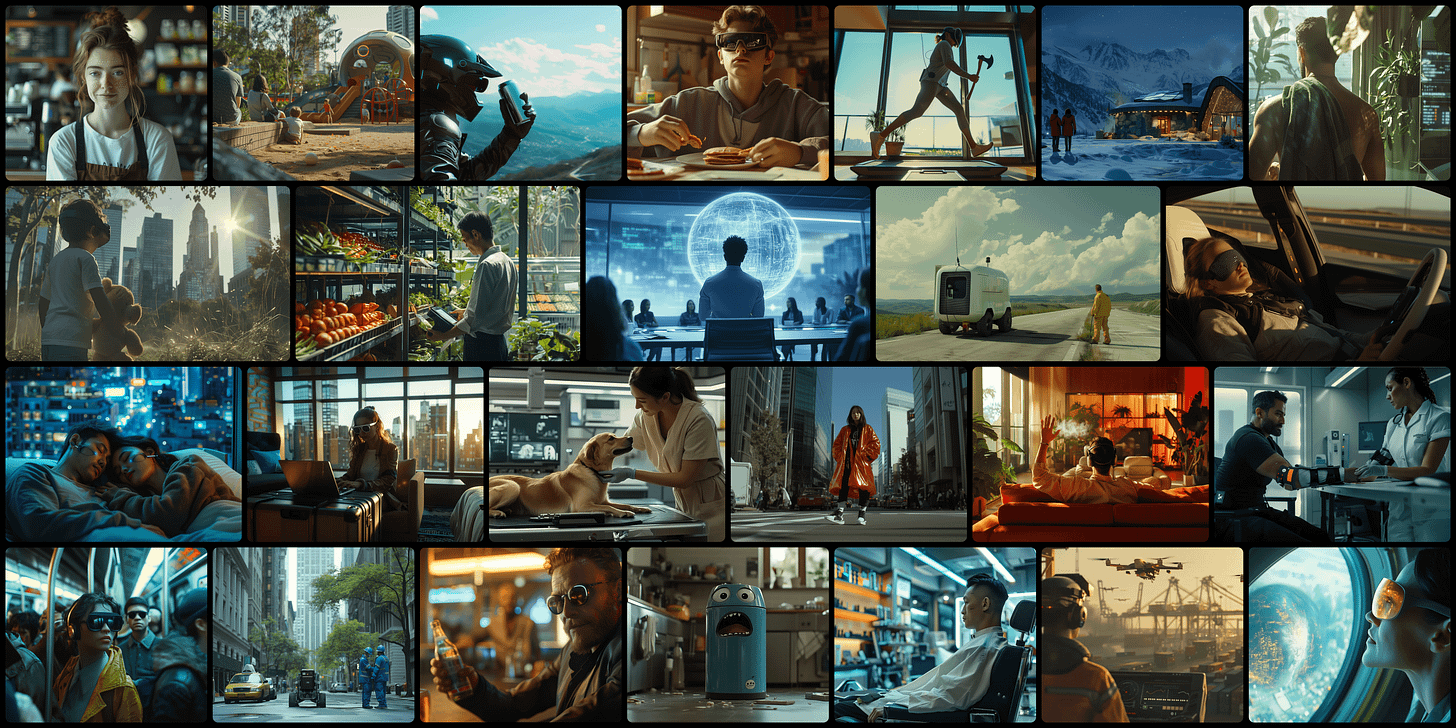Who approved this weather?
Their director storms into the monitoring room, glancing at the screens.
- Who approved this weather? This model hasn’t been cleared yet!
Her analyst puts the monitoring dashboard on the wall screen.
- It’s already being used in hundreds of live sims.
The director adjusts the glasses, thinking.
- What’s cooking?
- The usual standard. Construction. Materials. Coatings. Consumer products. Insurance premiums. Everything you’d like to get virtually tested for 10 years of weather exposure, in under a week.
- All regions?
She nods, confirming.
- All of them. We can’t pull it out for at least the next few cycles.
- Tell me something I don’t know.
He takes a deep breath, trying to focus by playing with his glasses.
- Ok. Let’s figure something out. The model is nice but the environmental parameters may be off. If someone is using this for severe thunderstorms, it may not perform as intended.
- What’s the big deal?
- This weather is based on outdated 4.1 climate specs. It should have been promoted to 4.2 before it was released. You wouldn’t waterproof your roof for yesterday’s storms.
She turns to her console and starts swiping through legal protocols.
- Let me reach out to legal. We have a mitigation scenario for version transitions.
The analyst adds.
- There should also be a safeguard that extends the norm beyond the required threshold.
The director crossed his arms unconvinced.
- I know we’ll be fine. I’m only worried about the fallout when our clients realise they pushed their digital twins through hundreds of power-hungry sim cycles using the wrong weather model.
- Hmm. That’s a fair point. How can we communicate this?
- I’m still waiting for an in-person confirmation, but the AI counsellor claims we usually have a 10% margin over all the reqs.
- This meets the norm.
She waves a chart from her console to the main wall screen.
- Not as simple as it seems. Look at the divergence patterns.
The screen renders the simulations at accelerated speed. Initially, variations are small, but within moments, dynamic alerts pinpoint critical divergences in storm patterns.
- The regulatory floor is covered, yes. But our reputation is built on predictive accuracy, not merely meeting minimums.
Cornered, he crosses his arms and studies the projection as it renders.
- What about clients running storm resilience certifications? Can we run a focused assessment on current usage?
- No need. That's what triggered the alert. StormShield Composites is testing hurricane-resistant building materials. Their simulated storm patterns under 4.1 are significantly different from those in 4.2 projections. Especially…
She double-checks the breakdown.
- …wind shear and sustained pressure dynamics.
Their legal advisor appears on the wall screen, casually waving at the group.
- Good afternoon, everyone. Our frameworks exceed all legal reqs by 15%. Technically, we're covered but we strongly suggest notifying clients with a priority flag for infrastructure testing.
- And a comp package? What's our exposure?
- Standard. Extended simulation credits at 120% of affected runtime, priority processing queue for re-runs, and free consultation on result interpretation differences. Acceptable for Q3 energy allocation.
He rubs his temples, thinking, glancing at the resource allocation dashboard pulsing quietly in the corner.
- We should get ahead of this. How many cycles before we can patch it with a full 4.2?
- Three minimum. But we can push a differential layer by end-of-day that runs parallel comparisons, showing both models side by side. It won't fix the core issue, but it will give us visibility on discrepancies.
- Do it. And prep a transparency brief. I want clients to see we caught this ourselves instead of waiting for them to discover it. And don’t call it a rollback.
A junior analyst, who has been quietly monitoring the feeds, raises his hand and clears his throat.
- Um... I know this might sound strange but... actually, this might be a huge data capture opportunity. Imagine the insights we’d gain comparing 4.1 and 4.2 models across thousands of live sims simultaneously. With the right telemetry setup, this could be the largest controlled test of norm transition effects we've ever collected.
- Brilliant! Add this to the brief. "Exclusive access to transition insights" sounds much better than "We screwed up big time"! How quickly can you draft a telemetry capture framework?
She smiles in relief, swiftly dragging resource tiles on her touchscreen, reallocating processing capacity.
- So we're turning this into a feature? Classic.
- Headfirst into the unexpected. Get a team to design the telemetry package and coordinate with client relations on messaging. Emphasise the research angle.
- What about the resources? Running dual simulations will increase processing demands by about 40% for affected clusters.
- Approved. That’s exactly what we have reserves capacity for. And ping the research team, this could make an excellent case study for their keynote. If we play this right, we'll come out looking like visionaries rather than firefighters.
As they shift into solution mode, his comms starts pulsing with a high-priority call request.
- Folks, it's the CTO of StormShield Composites. They are our largest account.
He squares his shoulders, suddenly looking more energised than worried.
- Perfect timing. Instead of apologising, we're about to offer them exclusive climate transition insights that nobody else in their industry will have.
The room falls silent as he prepares to accept the call with newfound confidence.
- Ready?
He takes a deep breath to calm his voice and subtly shifts his posture into presentation mode.
- Always. The best weather comes after the storm.
Hello Practical Futurists,
Welcome back from the future, where companies guarantee their products only after having run them through decades of virtual stress testing in our world’s digital twins first.
Hit the "Like" button at the top or bottom of this page to help other strategic thinkers build a future-ready mindset.Great leaders don't just think about the future. They experience it.
Like elite athletes who vividly visualise their performance, exceptional leaders build detailed mental pictures of possible futures to inform better decisions today.
Each week, our imagination workouts combine futures thinking and practical sci-fi, helping you build a personal library of future memories. These vivid mental scenarios transform abstract possibilities into clear reference points, sharpening your strategic instincts and enhancing your readiness for the age of AI.
Ready to expand your imagination? Start here:
Now, let's make this future personal.
We'll connect the ideas from this story directly to your life, turning abstract possibilities into practical memories you can use to confidently navigate tomorrow's challenges.
Personal life reflection prompts
1. When faced with an unexpected problem, do you tend to focus on damage control or on finding opportunities within the challenge? What does this demonstrate about your approach to resilience?2. If you could create accelerated simulations of real-world conditions to test aspects of your personal life, which 3 areas would you prioritise and why?3. Think about that time when you first used accelerated simulations for major life decisions: - Which three areas of your life benefited the most and why? - What unexpected insights emerged that traditional planning methods would have missed? - How did having compressed timelines change your decision confidence? - What would you simulate differently if you could do it again?
4. In what 2 ways might digital modelling and prediction technologies change how you plan for long-term personal decisions such as housing, education, or retirement?5. Think about how digital modelling transformed your approach to major life decisions: - What long-term planning did you approach differently because of prediction technologies? - Which decision would have been impossible to make confidently without simulation tools? - How did having multiple scenario projections change your relationship with uncertainty? - What surprised you most about the accuracy of the predictions versus reality?
6. Reflect on a personal setback you had experienced that ultimately provided valuable data or insights you wouldn't have gained otherwise. How did you turn this challenge into an opportunity?Fantastic work!
You're building an impressive collection of future-focused insights. Now, let's supercharge your thinking by adding powerful professional leadership moments.
How will you guide your team or organisation through the future you've just envisioned? Let's create memorable leadership experiences together.
Professional life reflection prompts
1. What long-term trends does your organisation struggle to forecast that might benefit from advanced prediction or simulation technologies?2. Try to recall the first month after implementing advanced prediction tech for those challenging long-term trends your organisation had struggled to forecast: - Which previously unpredictable patterns suddenly became clear? - What organisational resistance did you encounter when introducing the new forecasting methods? - How did the improved prediction capabilities change your strategic planning cycles? - What competitive advantage emerged from your enhanced forecasting abilities?
3. How can you ensure that insights from less experienced team members receive proper consideration during problem-solving discussions?4. How might compressed experimentation or accelerated simulations benefit your industry's development cycles or decision-making processes?5. Think back to that quarter when your team first implemented accelerated simulation technologies in your product development cycle: - Which processes improved most significantly by compressed experimentation? - Which decision-making bottlenecks were eliminated through simulation? - How did you ensure that accelerated results would translate to real-world conditions? - What unexpected competitive advantages emerged from faster cycles?
6. What communication strategies could your organisation develop to reframe problems as opportunities? How might this change the perception of clients or stakeholders?You did amazing! Excellent work!
Today's insights are valuable additions to your growing library of future experiences.
Thank you for expanding your imagination with us. Leaders with bold ideas move our world forward.
Think bright, and see you soon.
Pawel Halicki
Add your dose of Practical Futurism to your LinkedIn scroll
Connect with even more future-focused professionals.
Do you want stories like this in your inbox?
Join strategic imagination workouts that inspire change-makers in market-leading organisations, including Visa, Deloitte, Barclays, UEFA, Nielsen, Morgan Stanley, and many more.





